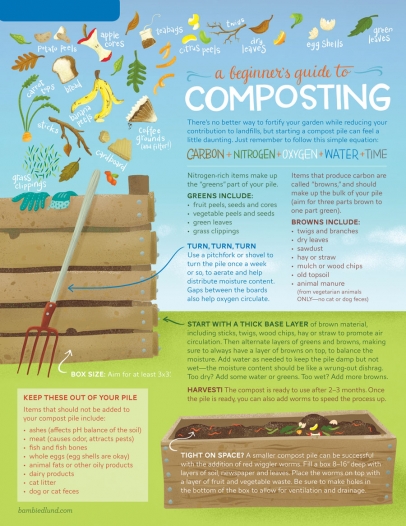A Beginner's Guide to Composting
There s no better way to fortify your garden while reducing your contribution to landfills, but starting a compost pile can feel a little daunting. Just remember to follow this simple equation:
CARBON + NITROGEN+ OXYGEN +WATER+TIME
Nitrogen-rich items make up the "greens" part of your pile.
GREENS INCLUDE:
• fruit peels, seeds and cores
• vegetable peels and seeds
• green leaves
• grass clippings
Items that produce carbon are called "browns," and should make up the bulk of your pile (aim for three parts brown to one part green).
BROWNS INCLUDE:
• twigs and branches
• dry leaves
• sawdust
• hay or straw
• mulch or wood chips
• old topsoil
• animal manure (from vegetarian animals ONLY– no cat or dog feces)
TURN, TURN, TURN
Use a pitchfork or shovel to turn the pile once a week or so, to aerate and help distribute moisture content. Gaps between the boards also help oxygen circulate.
START WITH A THICK BASE LAYER of brown material, including sticks, twigs, wood chips, hay or straw to promote air circulation. Then alternate layers of greens and browns, making sure to always have a layer of browns on top, to balance the moisture. Add water as needed to keep the pile damp but not wet–the moisture content should be like a wrung-out dishrag. Too dry? Add some water or greens. Too wet? Add more browns.
HARVESTI The compost is ready to use after 2-3 months. Once the pile is ready you can also add worms to speed the process up.
KEEP THESE OUT OF YOUR PILE
Items that should not be added to your compost pile include:
● ashes (affects pH balance of the soil)
● meat (causes odor, attracts pests)
● fish and fish bones
● whole eggs (egg shells are okay)
● animal fats or other oily products
● dairy products
● cat litter
● dog or cat feces
TIGHT ON SPACE? A smaller compost pile can be successful with the addition of red wiggler worms. Fill a box 8-16"deep with layers of soil, newspaper and leaves. Place the worms on top with a layer of fruit and vegetable waste. Be sure to make holes in the bottom of the box to allow for ventilation and drainage.




